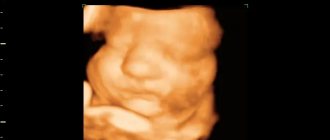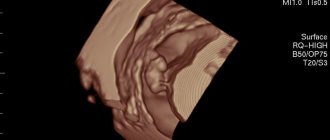What problems can a pregnant woman have at 27 weeks?
At 27 weeks of pregnancy, some expectant mothers may experience involuntary urination that occurs during sneezing or loud laughter. This is due to the fact that the uterus at 27 weeks of pregnancy puts quite a lot of pressure on the bladder. To avoid an awkward situation, use special sanitary pads. Heartburn during pregnancy, nausea and frequent constipation are also the result of pressure from the uterus on the internal organs. Try to eat small portions, but often, do not overindulge in sweets and starchy foods. Compliance with the drinking regime, feasible physical activity, exercises for pregnant women - all this will also help you cope with ailments.
The third trimester is a time of special control. The expectant mother should pay attention to the number of fetal movements, the nature of the discharge (for example, bloody discharge may indicate placental abruption, and watery discharge may indicate the onset of premature labor) and specific pain. Timely diagnosis by the attending physician will help you avoid troubles and carry your baby to term.
Weight gain at 27 weeks of pregnancy ranges from 5.2 kg (with a BMI of more than 26) to 9.2 kg (with a BMI of less than 19.8). To calculate your individual weight gain at 27 weeks, use the pregnancy weight gain calculator.
25,26,27,28 weeks of pregnancy: what happens, development of pregnancy and fetus
- home
- Services and prices
- Services and prices
- About Us
- Doctors
- Schedule and appointments
- Reviews
- Doctor training
- Clinic addresses
- Blog
- CIropedia
Week by week 25 - 28 weeks of pregnancy Elena Gevorkova Obstetrician-gynecologist, Moscow
Week 25
BABY
The weight of the fetus at this stage is 700-750 g, and the body length is 30-32 cm. The baby’s face has a familiar appearance, the cheeks, eyelids, eyebrows, and nose are clearly formed. The ears are pressed to the head, the cartilage is thin and soft, capillaries are visible through them. The skin becomes more elastic due to the accumulation of the subcutaneous layer of fat, folds and wrinkles are gradually smoothed out.
Fetal movements are distinct and rhythmic. At this stage, the baby’s periods of sleep and wakefulness are already formed. Moreover, sleep has rapid and slow phases - just like in adults. The intensive development of the fetal osteoarticular system continues. Bone strengthening occurs due to the accumulation of calcium, fluorine, magnesium, etc. compounds. – inorganic salts that ensure the strength of bone tissue.
Future mom
The general condition of the expectant mother does not undergo significant changes compared to previous weeks. Perhaps the growing uterus somewhat restricts movement and limits the duration of walks and exercise. Correctly selected clothes, shoes and, if necessary, a bandage can significantly change the situation and provide a woman with comfort.
If signs of rapid fatigue, shortness of breath, drowsiness, and rapid heartbeat appear, then this is a reason to pay attention to the hemoglobin level in a clinical blood test. Such symptoms may indicate anemia in pregnancy. In this condition, which is commonly called anemia, the concentration of hemoglobin in the blood decreases. During pregnancy, in the vast majority of cases, we are talking about iron deficiency anemia. Iron is part of hemoglobin, a special complex protein found inside the red blood cell. Thanks to iron, hemoglobin binds oxygen and transports it from the lungs to the tissues. Every cell in the body needs oxygen to produce energy. Thus, iron deficiency leads to oxygen starvation of tissues.
In expectant mothers, iron consumption occurs intensively due to the fact that the development of fetal tissue requires a large amount of energy, and therefore iron. Anemia in pregnant women can become an additional risk factor for the development of many complications: late toxicosis - gestosis, premature birth, fetal development disorders, etc.
Anemia during pregnancy is not an independent disease and is called physiological anemia, or anemia of pregnant women. But if the hemoglobin level drops to low levels, then prescribing iron supplements is completely justified. Anemia in pregnant women can be completely asymptomatic, so it is extremely important to take all tests in a timely manner to keep the situation under control.
Week 26
BABY
The growth of the fetus at this stage is 32-34 cm, and the weight reaches 850-900 g.
26 weeks of intrauterine development are considered a special period, since at birth during this period the fetus has the opportunity to survive. Of course, it is worth noting that such chances are small and the vitality of the child, which is determined by his individual adaptive capabilities and the availability of special equipment, is of great importance.
At this stage, the maturation of lung tissue occurs - the most important process in the formation of the respiratory system. The smallest bubbles of lung tissue - alveoli - are in a collapsed state during the prenatal period. The first breath after birth straightens the lung tissue. When air enters the lungs, it is extremely important that the alveoli expand and maintain just such a rounded shape - like bubbles in a sponge. The inner surface of each alveoli is lined with a special substance - surfactant. It is this that prevents the alveolar bubbles from sticking together when exhaling. If the surfactant content is insufficient, then a premature baby will develop a severe pathology - respiratory failure. The chances of survival in premature babies are largely determined by the quality and quantity of this important substance - surfactant. It is worth noting that today there are medications - analogues of surfactant, which significantly increase the chances of premature babies to recover.
The fetal reproductive system also undergoes important developmental stages. At this stage, boys' testicles begin to descend into the scrotum. This process takes several weeks, and by the time of birth the testicles should take their final place in the scrotum: this is one of the signs that the baby is full-term. In girls, by 26 weeks the formation of the external genitalia and vagina is completely completed.
Future mom
At the 26th week, the fundus of the uterus reaches 6 cm above the navel. The growth of the uterus is usually 1 cm per week. Most often, the height of the uterus corresponds to the gestational age in weeks. So, at a period of 26 weeks, the fundus of the uterus rises above the pubis - the so-called pubic symphysis - by 26 cm.
Fetal movements at this stage are very active; a sufficient amount of amniotic fluid allows the baby to make a variety of movements. Sometimes they are perceived by the pregnant woman as sensitive and even painful. Internal organs: bladder, intestines, stomach, liver - are under pressure from the growing uterus, and additional stress in the form of active fetal pushes can aggravate sensitivity. At such moments, you need to change your position, lie down, and choose a comfortable position. Most often, it is a change in body position that leads to relief. If such pain occurs frequently, several times a day and does not go away within an hour, then you need to tell your doctor about it.
Week 27
BABY
The weight of the fetus at the 27th week is about 900-1000 g, and the height reaches 34 cm. The baby’s motor activity is still high, especially the strength of movements of the arms and legs increases. This happens due to an increase in muscle mass and daily training: all this helps the fetus prepare for childbirth, because the movements of the limbs, in particular the straightening of the legs, play a big role when passing through the mother’s birth canal.
During this period, important events occur in the organs of the endocrine system of the fetus: in its brain, namely in a small gland - the pituitary gland - growth hormone - somatotropin - begins to be produced. This hormone regulates metabolic processes in cells, stimulates body growth, and the baby noticeably elongates in length.
Most of the endocrine glands of the fetus are already formed, however, from 27 weeks there is a significant increase in the activity of the organs of the endocrine system. Thus, the thyroid gland begins to produce three main hormones - thyroxine, triiodothyronine and calcitonin, which take part in all the most important metabolic processes. These hormones regulate the activity of the brain, cardiovascular and respiratory systems, and much more. Before this period, all these hormones functioned, but the main function was performed by the mother’s hormones. Now the baby’s hormones provide their needs independently.
All this determines the most important stage in the formation of the fetus’s own type of metabolism. Features of the immune system, constitution, reactions to stress, adaptability - all these specific individual reactions are formed precisely at this stage of pregnancy and are closely related to the beginning of the “independent” life of the organs of the endocrine system of the fetus.
Future mom
Often during this period, pregnant women notice an improvement in their health, and this is also due to the peculiarities of the endocrine system of the fetus. The mother’s thyroid gland stops working “for two,” which significantly improves the mother’s condition if before this period there were problems with hormonal regulation.
At around 27-28 weeks, many pregnant women begin to experience unusual sensations that were not there before, such as tingling in the arms and legs, a feeling of “pins and needles”, and changes in sensitivity. The most common manifestations of this kind also include spasms in the leg muscles - cramps. Painful cramps most often occur in the calf muscles, in the evening or at night, and last for several minutes. These ailments are associated with changes in the metabolism of magnesium and potassium in the muscles, as well as with the peculiarities of blood circulation during pregnancy. Blood flow in small vessels of peripheral organs - in the arms and legs - is often affected in expectant mothers. These phenomena are not a pathology, most often do not require serious treatment and disappear after childbirth.
In addition to the characteristics of blood circulation, cramps can be triggered by a number of other reasons - varicose veins of the legs, a lack of electrolytes in the blood - calcium or magnesium, pressure from the uterus of large veins, etc. If such symptoms appear, it is necessary to change the position of the body, slowly bend the leg at the knee, lifting it up. You can rub the painful area of skin or apply a towel soaked in cold water to it.
During a visit to the doctor, you need to inform him about such problems: this may require additional examination or treatment.
Week 28
BABY
By the end of 28 weeks, the baby is 35 cm tall, and its weight reaches 1100-1200 g. The fetal body becomes more and more rounded, and subcutaneous tissue accumulates. The vellus hairs covering the baby's entire body begin to gradually fall out and remain in small quantities in the area of the shoulders, back and lower back. The hairs on the head, eyebrows and eyelashes darken, which gives the fetus a more “adult” appearance. From 28 weeks, the baby often opens his eyes slightly and blinks his eyelids. His auditory organs are actively improving.
Future mom
The height of the fundus of the uterus by this time reaches 28 cm above the level of the pubic symphysis. Weight gain can be 7-10 kg depending on the initial body weight.
In case of multiple pregnancy, from 28 weeks, a certificate of incapacity for work is required - maternity leave.
The period of 28 weeks is significant for pregnant women with Rh-negative blood. Rh conflict is a pathological condition that occurs when a Rh-negative mother and an Rh-positive fetus are combined. Rh factor is a protein located on the surface of the red blood cell. If it is present, people belong to the Rh-positive group, and if it is absent, they belong to the Rh-negative group. If the blood of a Rh-positive person enters the blood of a Rh-negative person, then the body perceives these same Rh proteins as foreign and produces “weapons” against them - antibodies.
Damage to fetal tissue during Rh conflict occurs due to the fact that the mother's antibodies destroy the fetal red blood cells. However, for the development of Rh conflict, a significant accumulation of antibodies in the mother’s blood is necessary, which occurs only during pregnancy with an Rh-positive fetus. Thus, during the first pregnancy the risk of developing a conflict is negligible.
It is at 28 weeks that the first administration of anti-Rhesus immunoglobulin is recommended. This is a special “vaccination” against the development of Rh conflict in the future. Anti-Rhesus immunoglobulin binds the fetal red blood cells and “does not allow” the mother’s body to produce antibodies. Thus, the formation of the immune response is inhibited.
The second administration of immunoglobulin is carried out in the maternity hospital, in the first 72 hours after birth. A necessary condition for this vaccination is the absence of Rh antibodies in the blood of the pregnant woman: this is considered proof that there is no Rh conflict. The administration of anti-Rhesus immunoglobulin has a preventive purpose, i.e. prevents the occurrence of Rh conflict in subsequent pregnancies.
If Rh antibodies are detected, their value must be carefully monitored. An increase in antibody titers over time indicates the development of Rh conflict. In this case, the pregnant woman must be hospitalized in a maternity hospital, where the condition of the mother and baby will be constantly monitored - blood tests, ultrasound, Doppler, CTG, amniotic fluid testing, etc.
There is no specific treatment for Rhesus conflict. Therapeutic measures: intrauterine blood transfusion, plasmapheresis, plasma immunosorption, etc. - are aimed at weakening the immune response of the expectant mother until the stage of pregnancy, when the viability of the fetus will allow early delivery: as a rule, this is a cesarean section at 34 weeks.
How the baby grows at 27 weeks
At 27 weeks, the baby is about the size of a butternut squash.
At week 27, your Baby is 32-33 cm tall and weighs 800-900 g. What happens:
- your Baby’s skeleton continues to strengthen and muscles develop;
- he stretches, kicks, rolls over from side to side. And you don’t even need an ultrasound to see how the Baby pushes you with his fist or heel;
- a special substance, surfactant, begins to form in the lungs, which will then enable the Baby to breathe, and gradually this process will become more and more active (see the thirty-third week);
- accumulation of hormones continues in the pituitary gland;
- vellus hair on the body begins to darken;
- the first stool (meconium) is formed in the intestines;
- The baby is useful and likes it! — contrast shower and other (non-hazardous to the mother’s health) hardening procedures;
- the formation of sense organs is very active: your Baby is already able to distinguish some smells, has a sense of taste, and if there is light outside the wall of his mother’s belly, your Baby will notice this;
- The baby feels pain and reacts to it in almost the same way as a full-term baby;
- a decisive stage in the development of the cerebral cortex begins: neural connections become more and more active and prepare the ground for the full development of the Baby after his birth.
Feel
As mentioned above, a woman may experience some discomfort due to the fact that the enlarged belly puts pressure on the intestines and stomach, as well as on the diaphragm. This causes digestive problems in the form of belching, heartburn and constipation. Sometimes there is a feeling of numbness in the upper and lower extremities.
To minimize discomfort, you need to follow simple recommendations:
- Spend time outdoors;
- Eat properly;
- Do not sit or stand for long periods of time;
- Do not lift heavy objects;
- Ventilate the room before going to bed.
These tips will also help you get rid of insomnia and headaches, and improve your mood.
Another leading sensation for a woman during pregnancy is fetal movements. From them you can understand what the baby is doing, as well as judge his well-being. It largely depends on the emotions that the woman herself experiences, so by all means you need to maintain a positive attitude, avoid stressful and conflict situations and rejoice in the fact that a new life is growing inside.
Tests and studies during pregnancy
ultrasound (ultrasound examination) - 24-26 weeks after the first day of the last menstruation.
Exclusion of malformations of the nervous system, determination of the quantity and quality of amniotic fluid, place of placenta attachment and its condition. You can determine the sex of the child. Clinical blood test - 24-26 weeks after the first day of the last menstruation. The hemoglobin level is examined.
Visiting a doctor monitoring pregnancy: once a month. Weighing, measuring blood pressure, measuring the height of the uterine fundus, listening to the fetal heartbeat.
General urine test - before each visit to the doctor. Indicates the quality of kidney function.
Nutrition
Mother's nutrition at 27 weeks of pregnancy
At the 27th week of pregnancy, proper nutrition plays an important role not only in the development of the fetus, but also in maintaining the woman’s health and normalizing her well-being. It is recommended to follow some rules that will improve digestion, avoid some complications of pregnancy, and fill the body with necessary substances:
- eat 5-6 times a day in small portions;
- finish eating before you feel full;
- do not mix several dishes into one meal;
- have breakfast with cereals (buckwheat, rice, oatmeal);
- for lunch, prefer protein foods: beef, lean pork or poultry, low-fat fish, fermented milk products, chicken eggs;
- During the day, eat fruits and vegetables, raw and boiled. Especially useful: carrots, beets, apples, bananas;
- have snacks with dried fruits and nuts: almonds, walnuts, dried apricots, prunes, etc. It is better to avoid peanuts;
- have dinner 2-3 hours before bedtime;
- eat yogurt or an apple before bed;
- observe the drinking regime. Unless otherwise prescribed by your gynecologist, drink at least 2 liters of fluid per day (preferably clean water);
- avoid harmful foods and semi-finished products;
- completely eliminate alcohol;
- unless otherwise recommended by your doctor, avoid coffee and strong tea;
- reduce the amount of salt consumed to a minimum.
Vitamins
At week 27, multivitamin complexes should be taken strictly as prescribed by the doctor. You should pay close attention to the prescribed dosage and duration of taking prescribed vitamins and minerals. It should be remembered that vitamins do not work alone and to normalize the level of one, it is necessary to take others. A specialist must identify a lack of microelements and, based on an understanding of the interaction of various substances, decide on the need to take a certain complex.
In case of incorrect self-prescription of vitamins or minerals of chemical origin, it is possible that the normal level of some substances may be exceeded, while others are deficient. This can lead to unpleasant consequences: excess weight, hypervitaminosis, etc. If a woman feels that her body is lacking a certain microelement, and consultation is not possible in the near future, the best option is a minor adjustment of the diet, replenishing the supply of the missing vitamin or mineral through food.
Good to know
Leg cramps: causes and treatment
Is insomnia an essential part of pregnancy?
Gymnastics during pregnancy
Colored pregnancy: the benefits of color therapy for the expectant mother
How do you know if everything is okay with mom and baby?
Is it possible for pregnant women... Train, car, plane: pros and cons
All texts for pages about mother and baby were kindly provided by RAMA Publishing - these are chapters from the book by Svetlana Klaas “Your Favorite Little Man from Conception to Birth”, reviewer Irina Nikolaevna Kononova, Candidate of Medical Sciences, Associate Professor of the Department of Obstetrics and Gynecology of the Ural State Medical Academy (Ekaterinburg).
Weight
By the 27th week of pregnancy, most women gain weight from 7 to 10.5 kg (from the weight established at registration). In some cases, a deviation from these indicators to a lesser or greater extent without pathology is possible. The gynecologist observing the pregnant woman should decide whether underweight or overweight is a dangerous symptom, based on tests, medical history, well-being and body mass index before pregnancy.
Over the next 7 days, it is advisable to gain no more than 500 g.
Determination of fetal condition
To determine the condition of the fetus, the doctor conducts a number of examinations:
Auscultation (listening)
The simplest thing is auscultation (listening) using a special wooden tube (obstetric stethoscope) or a special device that detects the fetal heartbeat; the doctor listens to the baby’s heartbeat. Normally it is about 120-160 beats per minute. A decrease in heart rate of less than 120 or an increase of more than 160 indicates intrauterine suffering in the child.
Ultrasound examination and Doppler testing
When performing an ultrasound, the doctor visually assesses the size of the fetus, the correspondence of fetal development to the gestational age, because with oxygen starvation the growth rate of the fetus slows down and its size lags behind the norm for each stage of pregnancy. The structure of the placenta and the presence of signs of aging in it also matter, as a result of which the function of transferring blood, oxygen and nutrients to the fetus usually deteriorates. During an ultrasound, the amount and type of amniotic fluid is assessed, which can also change with intrauterine fetal suffering. Doppler ultrasound of the blood vessels of the placenta and umbilical cord is a method for studying the speed of blood flow in these vessels. When the speed of blood flow in any vessel decreases, we can talk about fetal nutritional disorders of varying degrees of severity.
Cardiotocography (CTG)
This is an important method for assessing the condition of the fetus. CTG is performed during pregnancy of 33 weeks or more, since only in this period of intrauterine development of the baby is full regulation of the activity of the fetal cardiovascular system established by the centers of the spinal cord and brain. The fetal heartbeat is recorded for at least 40 minutes, and if necessary, the study can be extended to one and a half hours. The device detects and records the baby's heart rate. For example, when the oxygen concentration in the fetal blood decreases, the supply of oxygen to the cells of the nervous system decreases, which in turn affects the heart rate, especially when the child is awake. The obstetrician-gynecologist evaluates the heartbeat recording curve, episodes of decrease and sharp increase in the fetal heart rate and, based on these data, makes a conclusion about how comfortable the baby feels in the mother’s stomach.
If, during additional methods of assessing the condition of the fetus, initial disturbances in the supply of oxygen to the baby are detected, drug treatment is carried out aimed at increasing the access of blood and oxygen through the placenta and mandatory control examinations during the therapy. If the changes are profound and the baby experiences a severe deficiency of oxygen and nutrients, his condition suffers, an emergency delivery of such a patient is carried out.
Fetal movements are not only an indicator of its condition, it is a way for the baby to communicate with his parents. The movement of the baby in the mother's tummy is an unforgettable sensation that a woman can experience only in this short, but such a happy period of her life.
Diameter of fertilized egg by week
When the fertilized egg has a diameter of 4 millimeters, this indicates a fairly short period of time - up to six weeks.
- This is often the size of the fertilized egg at 4 weeks
. Already at five weeks, the SVD reaches 6 millimeters, and at five weeks and three days the fertilized egg has a diameter of 7 millimeters. - At the sixth week, the gestational sac usually grows to eleven to eighteen millimeters, and the average internal size of the gestational sac of sixteen millimeters corresponds to a period of six weeks and five days. At the seventh week of pregnancy, the diameter ranges from nineteen to twenty-six millimeters.
- At week 8, the fertilized egg
increases to twenty-seven to thirty-four millimeters. At this stage, the fetus can be clearly seen on ultrasound. - The fertilized egg
grows to thirty-five to forty-three millimeters in 9 weeks. - And at the end of the tenth week, the fertilized egg measures about fifty millimeters in diameter.
As you can see, the fertilized egg is at 4 weeks
It differs very much in size during the tenth week.
The question of how quickly the fertilized egg grows can be answered with confidence: until the fifteenth to sixteenth week, its size increases by one millimeter every day. Further, the diameter of the fertilized egg increases by two to three millimeters per day.
Next you can see the increase in the ovum by week in the table:
Average size of the fertilized egg in the first trimester of pregnancy
| Date of last menstruation (weeks) | Time at conception (weeks) | Inner diameter (mm) | Area (mm2) | Volume (mm3) |
| 5 | 3 | 18 | 245 | 2187 |
| 6 | 4 | 22 | 363 | 3993 |
| 7 | 5 | 24 | 432 | 6912 |
| 8 | 6 | 30 | 675 | 13490 |
| 9 | 7 | 33 | 972 | 16380 |
| 10 | 8 | 39 | 1210 | 31870 |
| 11 | 9 | 47 | 1728 | 55290 |
| 12 | 10 | 56 | 2350 | 87808 |
| 13 | 11 | 65 | 3072 | 131070 |
Average size of the embryo in the first trimester of normal pregnancy
| Date of last menstruation (weeks) | Time at conception (weeks) | Coccygeal-parietal size (mm) | Biparietal size (mm) | Yolk sac diameter (mm3) |
| 5 | 3 | 3 | — | — |
| 6 | 4 | 6 | — | 3 |
| 7 | 5 | 10 | — | 4 |
| 8 | 6 | 16 | 6,0 | 4,5 |
| 9 | 7 | 23 | 8,5 | 5,0 |
| 10 | 8 | 31 | 11,0 | 5,1 |
| 11 | 9 | 41 | 15,0 | 5,5 |
| 12 | 10 | 53 | 20,0 | 6,0 |
| 13 | 11 | 66 | 24,0 | 5,8 |
ovum size
Mother's well-being at twenty-fifth week
The expectant mother's belly is growing and her weight is steadily gaining (approximately 350 g per week). Now it is important to control your salt intake in order to avoid possible swelling. They can be not only unpleasant, but also quite dangerous. Mom feels great, but it is very important not to overload herself and take care of herself. A woman constantly needs positive emotions, good sleep and rest. This week, the fundus of the uterus rises above the pubis by 25 cm. If this distance is less, the doctor may note a delay in the development of the baby, so control is important. An enlarged uterus can limit physical exercise and the duration of walks, so it is very important for the mother to choose comfortable shoes and clothes; a bandage will help make the condition more comfortable. This week it is necessary to monitor the level of hemoglobin in the blood. Evidence of its decrease may be rapid fatigue, shortness of breath, and rapid heartbeat. This is a period of very active iron consumption, which is so important for the baby’s future. In this case, anemia may develop. It is not a disease, but is physiological in nature (occurs exclusively during pregnancy). Prescribing special iron supplements can always correct the situation and bring hemoglobin levels back to normal.
It is possible and it is not possible
A pregnant woman in the 27th week of pregnancy is recommended to follow some simple rules that will ensure suitable conditions for the development of the fetus, reduce the discomfort that appears during this period, and maintain health.
- avoid alcohol, nicotine, drugs;
- household and construction chemicals can lead to undesirable consequences. if it is necessary to use them, it is better to ask someone else to resolve the issue;
- follow a diet and daily routine. Eat 5-6 small meals a day and sleep about 8 hours at night;
- cleanliness is the key to health. Take care of your own hygiene and order in the house.
- involve loved ones in solving everyday issues: do not hang curtains yourself, do not lift heavy objects, avoid staying in a bent position for long periods of time;
- take care of your health. Avoid contact with sick people, do not go to places where there may be infected people. During the period of infections, it is better not to visit large stores and other crowded places, choosing a time when there are fewer visitors;
- Walk outside every day, preferably in a park, forest or near a pond. Try not to sit on a bench, but to walk;
- Do not sit in one position for a long time and cross your legs. It is recommended to warm up every 10-20 minutes during sedentary work;
- strive to maintain a good mood without getting upset due to absent-mindedness or forgetfulness.
Sex
In the absence of direct instructions from the gynecologist, sex at 27 weeks is not prohibited. If the expectant mother feels well and there are no unpleasant sensations, sexual intercourse is possible, subject to certain precautions:
- the chosen position eliminates pressure on the stomach;
- the pregnant woman is in a comfortable position, nothing bothers her;
- there are no sudden movements, rough deep penetrations, or elements that cause discomfort or pain to the pregnant woman.
It’s a good idea to use a condom during sexual intercourse from the 27th week. Semen contains large amounts of the hormone prostaglandin, which promotes cervical ripening. There is no point in stimulating this process this week.









